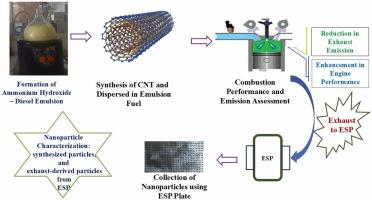碳纳米管催化和静电纳米颗粒过滤改善氢氧化铵-柴油混合物的环保性能
IF 11.3
1区 环境科学与生态学
Q1 ENGINEERING, ENVIRONMENTAL
引用次数: 0
摘要
本研究探讨了氢氧化铵与柴油的融合,重点是提高燃烧效率和减少排放。本研究通过引入碳纳米管催化剂,解决了氨在分解过程中高活化能的难题,显著提高了催化性能。此外,该公司还开发了一种静电除尘器(ESP),用于从发动机尾气中捕获纳米颗粒,防止其释放到大气中。利用SEM、EDX、XRD和FTIR对合成的纳米颗粒进行了表征,深入了解了其结构和表面性质。在不同条件下,在柴油发动机上测试了氢氧化铵(5%和10%)与柴油的不同混合物,并添加了100 ppm的纳米催化剂。结果显示,在发动机效率和燃油消耗方面有显著改善,分别降低了8.2%和7.9%。碳氢化合物、一氧化碳和氮氧化物的排放量分别下降了19.7%、10.7%和5.6%,证明了纳米催化剂增强的氢氧化铵燃料混合物的潜力。此外,对合成的纳米粒子和从电除尘器板上收集的纳米粒子进行了比较,证实了电除尘器在捕获降解纳米粒子方面的有效性。这强调了先进的过滤技术在减轻发动机尾气对环境污染方面的关键作用。这项研究的发现有助于开发更清洁、更高效的燃料技术。本文章由计算机程序翻译,如有差异,请以英文原文为准。

Environmental Performance Improvement of Ammonium Hydroxide-Diesel Blends via Carbon Nanotube Catalysis and Electrostatic Nanoparticle Filtration
This study explores the integration of ammonium hydroxide with diesel fuel, focusing on enhancing combustion efficiency and reducing emissions. The research addresses the challenge of ammonia's high activation energy during decomposition by introducing a carbon nanotube catalyst, which significantly improves catalytic performance. Additionally, an electrostatic precipitator (ESP) was developed to capture nanoparticles from engine exhaust, preventing their release into the atmosphere. The synthesized nanoparticles were characterized using SEM, EDX, XRD, and FTIR, providing insights into their structural and surface properties. Various blends of ammonium hydroxide (5% and 10%) with diesel fuel, enriched with 100 ppm of nanocatalyst, were tested in a diesel engine under different conditions. The results showed notable improvements in engine efficiency and fuel consumption, reducing by 8.2% and 7.9%, respectively. Emissions of hydrocarbons, carbon monoxide, and nitrogen oxides decreased by 19.7%, 10.7%, and 5.6%, respectively, demonstrating the potential of the nanocatalyst-enhanced ammonium hydroxide fuel blend. Furthermore, a comparative characterization of nanoparticles synthesized and those collected from the ESP plates confirms the ESP’s effectiveness in capturing degraded nanoparticles. This emphasizes the critical role of advanced filtration technologies in mitigating environmental pollution from engine exhaust. The study’s findings contribute to the ongoing efforts to develop cleaner, more efficient fuel technologies.
求助全文
通过发布文献求助,成功后即可免费获取论文全文。
去求助
来源期刊

Journal of Hazardous Materials
工程技术-工程:环境
CiteScore
25.40
自引率
5.90%
发文量
3059
审稿时长
58 days
期刊介绍:
The Journal of Hazardous Materials serves as a global platform for promoting cutting-edge research in the field of Environmental Science and Engineering. Our publication features a wide range of articles, including full-length research papers, review articles, and perspectives, with the aim of enhancing our understanding of the dangers and risks associated with various materials concerning public health and the environment. It is important to note that the term "environmental contaminants" refers specifically to substances that pose hazardous effects through contamination, while excluding those that do not have such impacts on the environment or human health. Moreover, we emphasize the distinction between wastes and hazardous materials in order to provide further clarity on the scope of the journal. We have a keen interest in exploring specific compounds and microbial agents that have adverse effects on the environment.
 求助内容:
求助内容: 应助结果提醒方式:
应助结果提醒方式:


